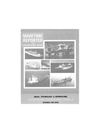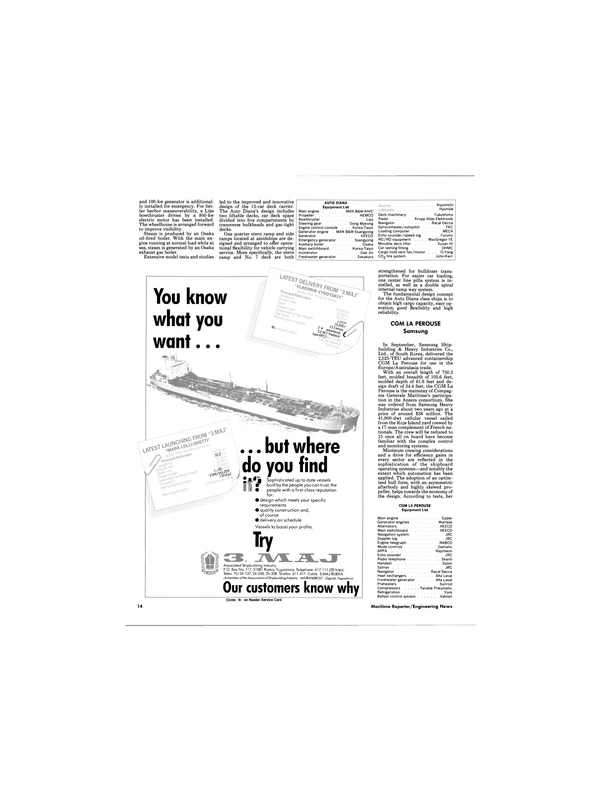
Three Engines—One Design Concept: MAN B&W's State-Of-The-Art Propulsion Family For The 90s
In the near future, an optimally graded MAN B&W four-stroke engine program of state-of-the-art design will be available in the output range between 3,300 kw and 12,000 kw, equipped to meet the propulsion requirements of the 90s. The new family is comprised of three MAN B&W medium-speed engines, all modeled on the same design principles.
Beginning with the largest engine, the L58/64, MAN B&W has created an engine series for a class of toprated engines designed with a view of achieving economy and reliability and equipped with every manner of future-orientated, technical and economical design characteristics.
With a piston diameter of 580 mm and a stroke of 640 mm, the L58/64 engine develops a cylinder output of 1,325 kw at a speed of 428 rpm, i.e., in the nine-cylinder version the engine is capable of an output of approximately 12,000 kw.
The "little brother," L40/54, which successfully completed its test bench trials at the end of 1987, with its cylinder output of 665 kw is modeled on the basic design concept of the L58/64 engine, an engine that has since proved itself in operation in numerous ships' propulsion plants. The first seven L40/54 engines will be supplied in early 1989.
The L48/60 engine currently under development plugs the output gap between the 40/54 and the 58/64 with its 885-kw per cylinder at a speed of 450 rpm. This engine was also modeled on the same futureorientated design concept.
All three engines are supplied as in-line configuration engines with between six and nine cylinders.
The principle design features of the MAN B&W medium-speed engine generation include: Very stiff, monoblock frame casing; underslung crankshaft; individual cylinder jackets, resulting in minimum deformation from gas and mass forces and thermal influences; connecting rod—optimized marine head design with parting line in the upper region of the rod shaft, i.e., extremely low overhauling height; exhaust valves arranged in cages resulting in simplified maintenance of components.
Also, propellers on the exhaust valve cones, resulting in rotation of the valve by the gas flow—valve seats remain free of deposits over many thousands of operating hours; fuel-optimized injection system with "economy plunger" and highinjection intensity; adjusting mechanism for optimizing the injection timing during engine operation; constant pressure turbocharging, i.e., higher turbocharger efficiency and low component temperatures; high compression ratio and correspondingly adjusted valve timing for problem-free and trouble-free HFO operation; consistently even exhaust gas temperature after turbine over a broad operating range ensures optimum utilization of waste heat.
MAN B&W's exhaust gas turbocharger with a very high level of aggregate efficiency over the entire load range permits a part of the exhaust gas flow to be branched off and utilized in a turbo-compound system, thus raising the aggregate efficiency of the propulsion plant; resilient mounting of the engines— the rigid design makes it possible to arrange the resilient bearing elements directly on the engine lands.
Low maintenance requirement thanks to an optimized maintenance concept: with only three different hydraulic tools, all the main screw connections can be slackened and re-tightened; rocker arm covers can be opened without great physical exertion and fix themselves in the open position; and the design and arrangement of the rocker arms makes for swift and simple removal of the exhaust valves.
According to MAN B&W, their new generation of medium-speed engines offer further reductions in fuel consumption rates (85% ECR): L40/54—172 b/kWh, L48/60—169 g/kWh, and L58/64—167 g/kWh; lube oil consumption rates of less than 1 g/kWh; significant reductions in pollutant emission levels; extensive utilization of various engine waste heats, resulting in a high aggregate efficiency of the propulsion system; long wear component lifetime and thus a low spare parts requirement; a simple maintenance concept tailored to the practice of day-to-day engine operation ensures short maintenance and turnaround times, which in turn means high engine availability and reduced manning levels.
For more information and free literature on MAN B&W engines, Circle 16 on Reader Service Card
Read Three Engines—One Design Concept: MAN B&W's State-Of-The-Art Propulsion Family For The 90s in Pdf, Flash or Html5 edition of December 1988 Maritime Reporter
Other stories from December 1988 issue
Content
- Diesel America Completes Diesel Pump O r d e r page: 5
- AMP Offers Low-Cost M e t h o d Of M a r i n e Cable S p l i c i n g — L i t e r a t u r e O f f e r ed page: 6
- McDermott Lays Keel For First Of Three C r a f t In $ 3 2 . 6 - M i l l i o n Contract page: 6
- B u t t e r w o r t h Adds Eighth U.S. Supply C e n t e r— M a r i n e H a r d w a re page: 6
- Kiene Offers Improved Diesel Compression Set page: 7
- Trinity Industries Acquires Aluminum Boats, Inc. page: 8
- Waugh To Supply TNF Joiner System For S.S. Azure Seas page: 8
- Sims Pump Valve Offers Durable Composite Impellers And Parts For Marine Use page: 8
- Three Engines—One Design Concept: MAN B&W's State-Of-The-Art Propulsion Family For The 90s page: 10
- MAN B&W Holeby's CODAG GenSet Is Said To Save Up To 50 Percent In Electricity Production Costs page: 11
- OUTSTANDING OCEANGOING SHIPS OF 1988 page: 12
- $29.4-BILLION FY89 NAVY BUDGET APPROVED FOR SHIPS AND EQUIPMENT page: 23
- MAJOR NAVY CONTRACTS page: 25
- U.S. SHIP MAINTENANCE & REPAIR— A $50 BILLION TO $60 BILLION 10-YEAR MARKET page: 28
- MMA Meeting Studies Changes In Navy Acquisition page: 36
- Philadelphia Sections Of SNAME, ASNE Hear Paper On Maritime Industry page: 37
- Halter Marine Delivers First Of Six U.S. Navy Ocean Surveillance Ships In $85-Million Contract page: 38
- Deck Cannister N o w Offered For Avon Coastline Life Raft page: 47
- Cummins-Powered Cruise/Dining Vessel 'Star Of Louisville' Now In Service On Ohio River page: 48
- High-Performance Coatings Division Acquired By Hempel From Reliance Universal page: 48
- Westmont Industries Offers Eight-Page Color Brochure On Port Equipment page: 49
- Sperry Marine To Distribute Northstar Computerized Loran-C Navigators page: 50
- Marine Ladders And Gangways Featured In N e w 38-Page Alco-Lite Catalog page: 57
- Trilling Medical's 'Water-Jet': Unique Product For Emergency Burn Care And Fire Protection page: 60
- TBT-Free A n t i f o u l i n g Range From International Paint Gets Enthusiastic Response page: 60
- Halter Marine Christens Fourth Of Six Ocean Surveillance Ships In $85-Million Navy Contract page: 60


